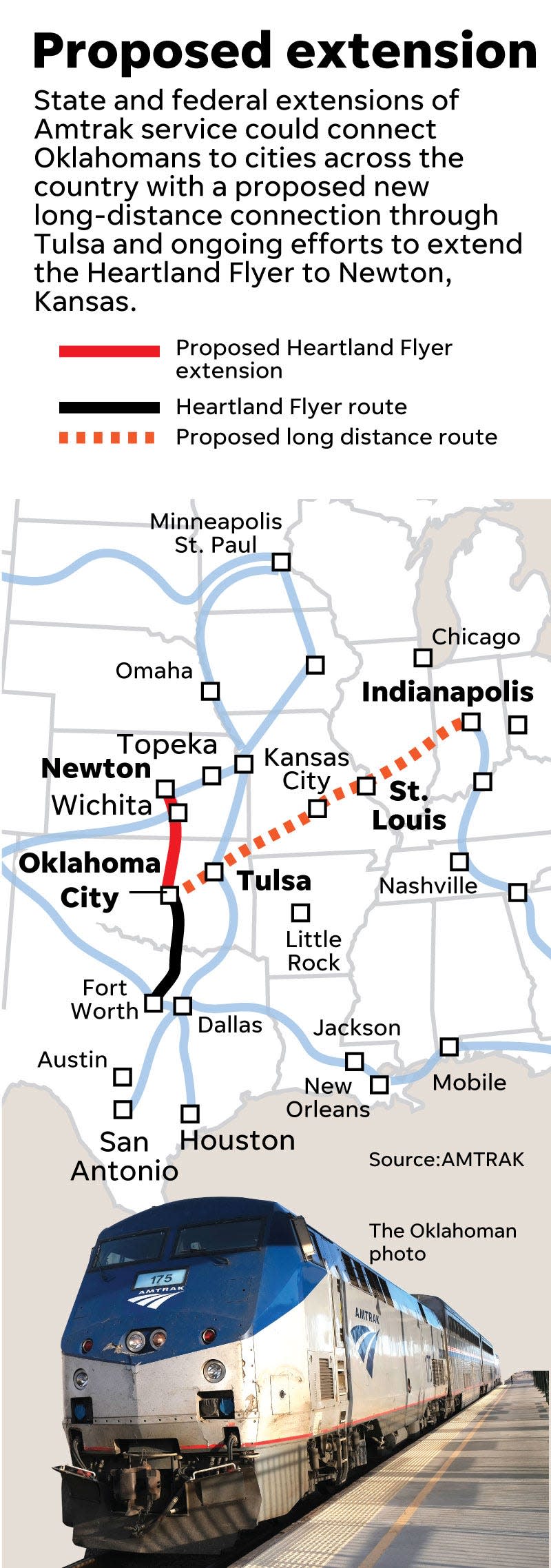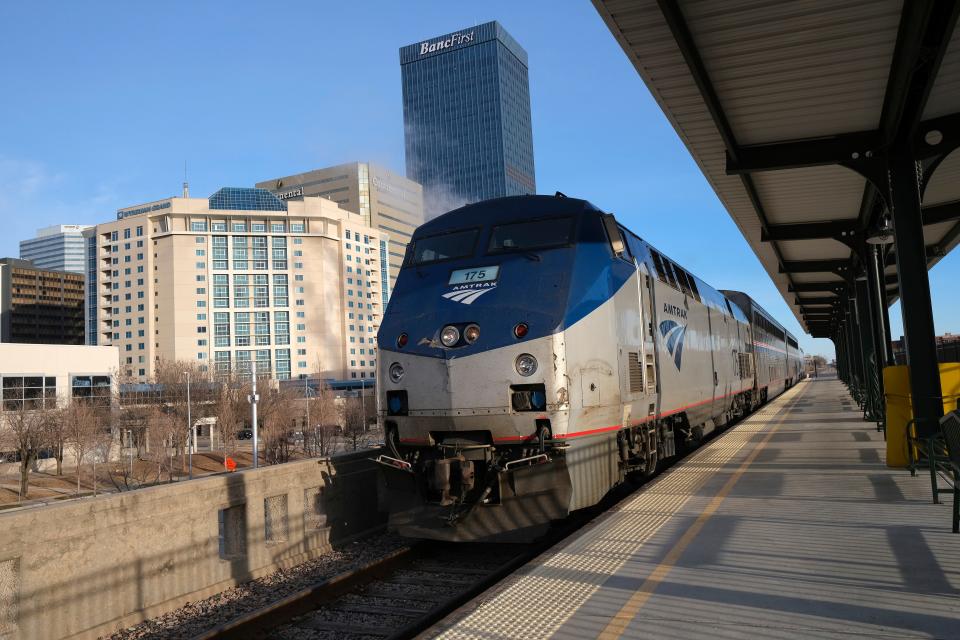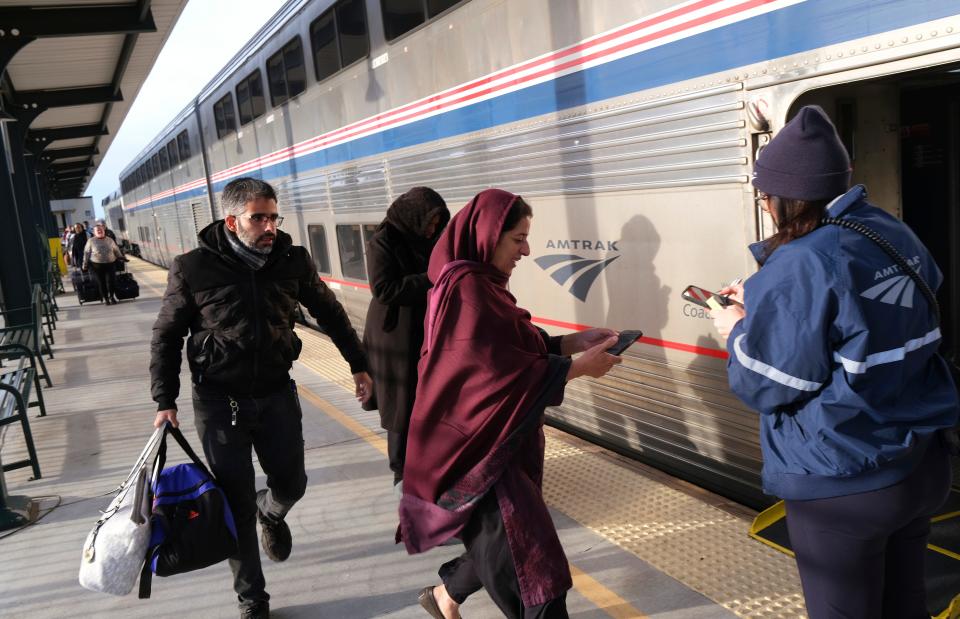Could national Amtrak route include stop in Oklahoma City?
Amtrak is looking at a nationwide expansion of its long-distance routes that would, if implemented, reconnect Oklahoma City and Tulsa with cities nationwide.
The study underway by the Federal Railroad Administration coincides with ongoing efforts led by Kansas transportation officials to extend the Heartland Flyer north from Oklahoma City, where it currently ends, to Newton, Kansas.
Bryce Boyer, spokesperson for the Oklahoma Department of Transportation, said the new route connecting Oklahoma City and Tulsa is one of 15 proposed long-distance corridors being looked at that are too expensive to be pursued by states and would be funded with federal infrastructure funding.
“These are in the early stages, they won’t pop up tomorrow,” Boyer said. “The railroad administration is looking long-range to help solve an issue that states haven’t been able to do. Building lines aren’t cheap. But at the federal level they can do that.”
Dozens of Oklahoma cities and towns were connected via passenger rail between the early and mid-1960s, but they quickly disappeared when the Rail Passenger Service Act was signed into law in 1970, ending requirements that railway companies provide passenger service.
Amtrak was created to take over passenger rail starting in 1971. Oklahoma was left as one of just a few states without passenger rail when the last route, the Lone Star, ended in 1979. Texas and Oklahoma entered into an agreement with Amtrak to restore service in 1999 between Fort Worth and Oklahoma City.

Increased ridership and support for Amtrak by President Joe Biden has led to hopes of expanding the passenger rail network. Amtrak is projected to set new record ridership and ticket revenue with 32.8 million passengers and tickets totaling $2.5 billion.
Amtrak spokesman Marc Magliari said the agency supports the efforts of the Federal Railway Administration to expand national routes.
“At Amtrak we want to double the current ridership by 2040,” Magliari said. “The way to do that is by having more trains on current routes and more trains to more places more often.”
The proposed passenger rail expansions in Oklahoma could, if fully implemented, restore Oklahoma City’s connection to the northeast rail corridor and most of the country’s major cities.
The proposed Heartland Flyer extension would link Kansas with Oklahoma City and Dallas/Fort Worth. All of the cities along the route would connect with Amtrak’s Southwest Chief, which serves Kansas City, Chicago and Los Angeles.
The expansion would provide passenger rail service to Guthrie, Perry, Ponca City, Arkansas City and Wichita.
Oklahoma Gov. Kevin Stitt said last year that he’d met privately with Pete Buttigieg, the U.S. secretary of transportation, to advocate for the expansion. At the time, he said Buttigieg urged the Republican governor to continue working with his Democratic counterpart in Kansas
Amtrak currently operates a bus line that covers the gap between Oklahoma City and Newton. Magliari points to the bus ridership as proof demand exists for the passenger rail expansion.

More: Regional transit election likely by early 2025, will fund commuter rail network
Amtrak reports 6,114 customers traveled on the overnight bus ride in the fiscal year ending Sept. 30, 2023. That’s an average of more than a dozen people each night riding the Heartland Flyer, the bus, and then the Southwest Chief. The bus departs Oklahoma City at 9:50 p.m. and leaves Newton at 4 a.m.
Boyer said Oklahoma and Kansas are working on the second phase of studies required to extend the Heartland Flyer. That study, funded with a $450,000 federal grant and $25,000 paid by each state, is looking at what a corridor will look like to establish service to Newton.
If the extension is deemed viable, the third phase will follow with preliminary engineering studies and a look at the environmental impact of new train service. The final phase would depend on both states allocating construction funding through the Federal-State Partnership for Intercity Passenger Rail program.

Magliari said passenger rail operations plummeted during the pandemic, but the recovery time proved helpful as travelers discovered private rooms on passenger trains that they deemed safer and more comfortable than driving or flying.
Magliari said shrinking transit options and ongoing congestion both in the air and on highways are making rail transportation an increasingly popular third option. During a recent presentation to Kansas lawmakers, Magliari quoted a Detroit newspaper article that noted “windshield time is wasted time.”
“In large parts of our country, there is no other public transportation,” Magliari said. “The bus network has shrunk to an almost infinitesimal size and continues to shrink under the current ownership of Greyhound. Air is very expensive, especially short distance air. People are looking for another way to travel other than looking through their front windshield.”

This article originally appeared on Oklahoman: New proposed national Amtrak routes include OKC and Tulsa

